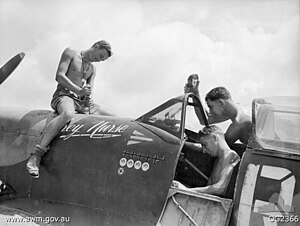Bobby Gibbes
Robert Henry Maxwell Gibbes, DSO, DFC & Bar, OAM (6 May 1916 – 11 April 2007) was an Australian fighter ace of World War II, and the longest-serving wartime commanding officer of No.Born in rural New South Wales, Gibbes worked as a jackaroo and salesman before joining the Royal Australian Air Force in February 1940.His great-grandfather, Colonel John George Nathaniel Gibbes, built his residence "Wotonga" at Kirribilli; the property was later refurbished to become Sydney's Admiralty House.[6] In a 1990 interview, he related that he had undertaken flying lessons at his own expense before enlisting, but "when war was declared, I thought I'd wait for King George to pay for the rest".[10] After completing flying training at Mascot and Richmond, New South Wales, and Point Cook, Victoria, Gibbes was commissioned a pilot officer on 28 June 1940.[22] On 20 November, during Operation Crusader, Gibbes took part in the destruction of a Messerschmitt Bf 110 with three other pilots, crash landing back at base with damage to his own aircraft.[11][28] Barr later said that although Gibbes was not a brilliant shot, he had the keenest eyesight of any pilot he knew when it came to locating enemy aircraft and alerting his fellows for the attack.3 Squadron pilot, Tom Russell, agreed that Gibbes was particularly adept at finding targets, and said that "if we got scattered in a dogfight he had the uncanny ability to get us back into formation in a very short space of time".[31] Gibbes was awarded the Distinguished Flying Cross (DFC) on 28 July 1942 for his actions on 26 May, the citation noting his "exceptional skill and gallantry".Gibbes threw out his own parachute to make room in the cockpit for his passenger and lost part of his undercarriage taking off, necessitating a one-wheeled landing back at base.[37][38] Recommended for the Victoria Cross for this action, he was instead awarded the Distinguished Service Order, which was promulgated on 15 January 1943 and cited his "outstanding qualities of leadership and enthusiasm".[29][39] Gibbes crash landed behind enemy lines on 14 January 1943, walking 50 miles (80 km) in the desert before being picked up by a British Army patrol.[37][40] He was awarded a bar to his DFC for this feat, and for his "exceptional leadership, skill and courage, contributing in a large measure to the success of the squadron he commands".[38][48] His rank of squadron leader confirmed the same month, Gibbes departed North Africa to serve at RAAF Overseas Headquarters, London, until October.[40] In December he met, in his own words, "a little dark-haired popsy" named Jeannine Ince, a volunteer with the Red Cross who had nursed him in hospital.[52] In April, Gibbes was one of eight senior pilots, including Caldwell and fellow aces Wilf Arthur and John Waddy, who tendered their resignations in protest at the relegation of RAAF fighter squadrons to apparently worthless ground-attack missions.As a former jackaroo, he was especially upset about one sortie that involved attacking cattle: "I felt horrible about it, being an ex bushy ... at about lunch time I went out and darned if I didn't have to turn butcher.1 TAF, Air Commodore Harry Cobby, himself shortly to be dismissed over the "mutiny", restored Gibbes to squadron leader effective 23 April.In January 1948, he formed Gibbes Sepik Airways using, among other types, three German Junkers Ju 52s, one of which was said to have been the personal transport of senior Luftwaffe commander Albert Kesselring.[60] Gibbes also established a tea and coffee plantation at Mount Hagen, New Guinea, in 1950, and served as a member of the RAAF Active Reserve, based in Townsville, Queensland, from 1952 until 1957.[40] A Spitfire in the "Grey Nurse" livery of one of Gibbes' World War II aircraft overflew the church, along with four F/A-18 Hornet jet fighters from No.



Robert Gibbs (disambiguation)SydneyRoyal Australian Air ForceWing CommanderNo. 23 SquadronNo. 450 SquadronNo. 2 OTUNo. 80 WingNo. 3 SquadronMiddle Eastern theatreSyria–Lebanon campaignWestern Desert campaignSouth West Pacific theatreDistinguished Service OrderDistinguished Flying Cross and BarMedal of the Order of Australiafighter aceNo. 3 Squadron RAAFNorth AfricaNew South WalesjackarooMiddle EastSouth West PacificNo. 80 WingAustralian First Tactical Air ForceMorotai MutinyJohn George Nathaniel GibbesKirribilliAdmiralty HouseYarralumlaGovernor-GeneralgrazierSopwith CamelAll Saints CollegeBathurstKing GeorgeRoyal Australian NavyMascotRichmondpilot officerNo. 23 SquadronCAC WirrawaysLockheed HudsonsArcherfieldflying officerDistinguished Flying CrossWellingtonRoyal Air ForceHudson bomberNo. 1 Squadron RAAFMalayan CampaignadjutantNo. 450 SquadronNo. 3 SquadronHawker HurricanesP-40 TomahawksJunkers Ju 88BeirutDewoitine D.520Vichy FrenchAleppoJohn JacksonOperation CrusaderMesserschmitt Bf 110Fiat G.50sMesserschmitt Bf 109TobrukJunkers Ju 87flight lieutenantsquadron leaderkangaroodachshundMacchi C.202siege of TobrukLuftwaffeEl Adembail outNicky BarrdogfightBattle of Alam el HalfaEl AlameinBattle of El AlameinSir Peter Drummonddouble centurynot outcockpitundercarriageVictoria CrosssortiesErrol FlynnBrian EatonRAAF Overseas Headquartersde Havilland MosquitoNo. 464 Squadron RAAFEmpire Air Training SchemeNo. 2 Operational Training UnitMilduraClive CaldwellDarwinSupermarine Spitfireswing leaderRed CrossDutch East IndiesMorotaiManilaWilf ArthurJohn WaddyAir Officer CommandingHarry CobbyMelbourneCoonambleJunkers Ju 52sAlbert KesselringMount HagenTownsvilleAnsett AustraliaGorokacatamarancivil aviationAustralian Story26 JanuaryPapua New GuineaMona Vale HospitalNorth SydneyChief of Air ForceGeoff Shepherd